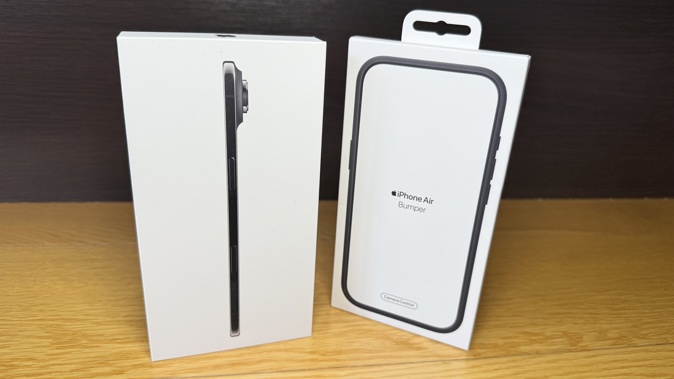
What I've learned from watching the world of tech pretty closely for a number of years now;
Things generally evolve steadily, bit by bit. Devices gradually improve - honing some features, adding new ones - and while the difference between one generation and the next may be slight, overall, when you compare most gadgets to their predecessors from four or five years ago, the improvements are thrown into stark relief.
But every now and again, a device launches that's more out-of-the-blue - even revolutionary.
Most of the time, that means a lot of excitement and hype - but also a lot of bugs and teething issues for early adopters to deal with.
What's rare is for something genuinely new to come along and for it to just work, straight out of the box.
The iPhone Air might just be the most significant iPhone since Steve Jobs showed off the first one back in 2007.
The way Apple has pretty much started from scratch to come up with the world's thinnest phone is so much more groundbreaking than it seems to be getting credit for.
Okay, at 5.6mm the iPhone Air is not actually thinner than a couple of folding phones out there (when they're unfolded) but for a conventional handset, this is definitely Apple's least conventional yet.
It really is quite breathtaking when you see it and hold it for the first time - in fact, I've yet to meet anybody who wasn't impressed when I showed it to them. It's not just that it's noticeably thinner than other phones, at just 165 grams, it weighs almost nothing. It exudes sci-fi movie vibes - you know; when they pull out a wafer thin piece of glass and use it as a phone.
There are four colours, Sky Blue, Light Gold, Cloud White and importantly, Space Black - making it the only black iPhone you can buy this year. (The "black" base model iPhone 17 isn't really black - looks more gunmetal to me)
The grade 5 titanium frame helps keep things light - and flexible. And this is one of the first big surprises about this remarkable handset; its durability. I've seen footage of drop, water ingress and flex tests that just about made my eyes pop out. The front of the phone is protected by the new Ceramic Shield 2, which offers multiple times more scratch resistance than ever before. There's also a Ceramic Shield coating on the back panel to prevent cracks.
This is good news because the iPhone Air is one phone I can't bring myself to hide away in a case.
Which is not to say there aren't cases available, of course. Apple also offers a bumper which protects the Air's edges without obscuring any of its unique design. This can be paired with the new Crossbody strap so you can wear the phone like a tiny handbag.
I usually just stuff it in my pocket - then have to keep checking if it's still there because it really is that slim.
Except for the "camera plateau" of course. This is a new design feature Apple has carried across to the iPhone 17 Pro and Pro Max as well - a raised camera bump that stretches all the way across the upper section of the rear panel. Intriguingly, I understand this new plateau houses more than just the camera; the vast majority of the iPhone Air's components are squeezed in there, with the rest of what's left of the phone mostly filled with battery.
Unfortunately, the camera is indeed one area where obvious compromises have been made to achieve the Air's final form. Although Apple claims the 48MP Fusion camera "puts the equivalent of four lenses in your pocket" in the end, there's only one physical sensor there and like the iPhone 16e camera before it, there are limitations. There's no Ultra-Wide functionality and no real macro shooting for extreme close-ups either.
However, that's not to say it's a bad camera. With the option to shoot at full 48MP, you get exceptional low-light performance and you also get respectable 2X optical zoom.
Action mode offers the stable video iPhone has become famous for and as part of the new iOS 26 upgrade, Apple now joins the Dual Capture club - so you can shoot from the selfie and primary cameras simultaneously.
Speaking of the forward facing camera, there's absolutely no compromise there. Just like the 17 Pros, the iPhone Air boasts an 18MP Centre Stage camera that has a square sensor - a bit like what you find on some dedicated action cameras. This enables you to change aspect ratio from portrait to landscape without having to awkwardly hold your phone sideways - very handy for group selfies. In fact, the new Centre Stage camera automatically senses how many people are in the shot and zooms in and out automatically to compensate.
This is a great demonstration of Apple's brand of AI (Apple Intelligence). Apple has been criticised for being slow off the mark when it comes to AI but I don't think that's the case at all. Instead, many AI features (like the auto-adjusting selfies) are so integrated, so baked-in that you won't specifically identify them as AI in itself.
When you first set up the iPhone Air (or any new iPhone) you're asked if you want to opt in to certain AI options - like prioritised notifications, for example. From that point on, that's exactly what happens; the important stuff is brought to your attention first. It works so well, you might not even realise how many pointless taps and swipes it's saving you.
As the fourth member of the 2025 iPhone family, the iPhone Air has replaced the absent iPhone 17 Plus by default. It's not a like-for-like comparison of course; the Plus versions were only ever the base models with bigger screens and batteries. Other than the camera, in terms of functionality, the Air works much more like a Pro - it's fast and silky smooth to use. But yes, in yet another surprise, the 6.5-inch display is larger than the 6.3-inch screen on the iPhone 17.
Better chip too - the all-new A19 Pro as opposed to the base A19 version.
For me, the biggest surprise of all is battery life. As part of its new host of accessories, Apple included a MagSafe Battery customised specifically to fit the iPhone Air. Inevitably, most of us assumed this meant the Air's battery life would be terrible and we'd need to supplement it with this magnetised external power supply. Except, I haven't had to use it. Not once.
Typically, I get up at 2:50Am and don't go to bed until around 8:30PM - that's a long day by smartphone standards but the lowest I've seen the Air's battery go is 48%. Apart from one morning when I left Apple Maps running in the background. Then it drained like bathwater down a plughole. For superusers, I guess that MagSafe Battery provides great piece of mind - especially given once its attached, the iPhone Air actually has the BEST battery life of ANY iPhone.
Oh - cool hack BTW; if you plug the Air into a USB-C charger while the MagSafe Battery's attached, you'll charge extra fast, from both sources simultaneously.
So battery just hasn't been an issue for me. Despite how slim the Air is, it still has all the cool buttons - including the Action button for programmable shortcuts and Camera Control for quick access to photo settings.
The only thing that's missing completely is a physical SIM tray - eSIM-only here and as far as I'm concerned, that's a bonus, not a drawback. The sooner we all move to eSIM the better - it's more secure and easier to transfer from handset to handset.
I love this phone. I didn't think I would. I loved the idea of it but when does a great, truly innovative idea like this ever work so well first time out of the gate? Kudos, Apple. You got me.
Click here for more information and pricing on the Apple iPhone Air.
Take your Radio, Podcasts and Music with you















